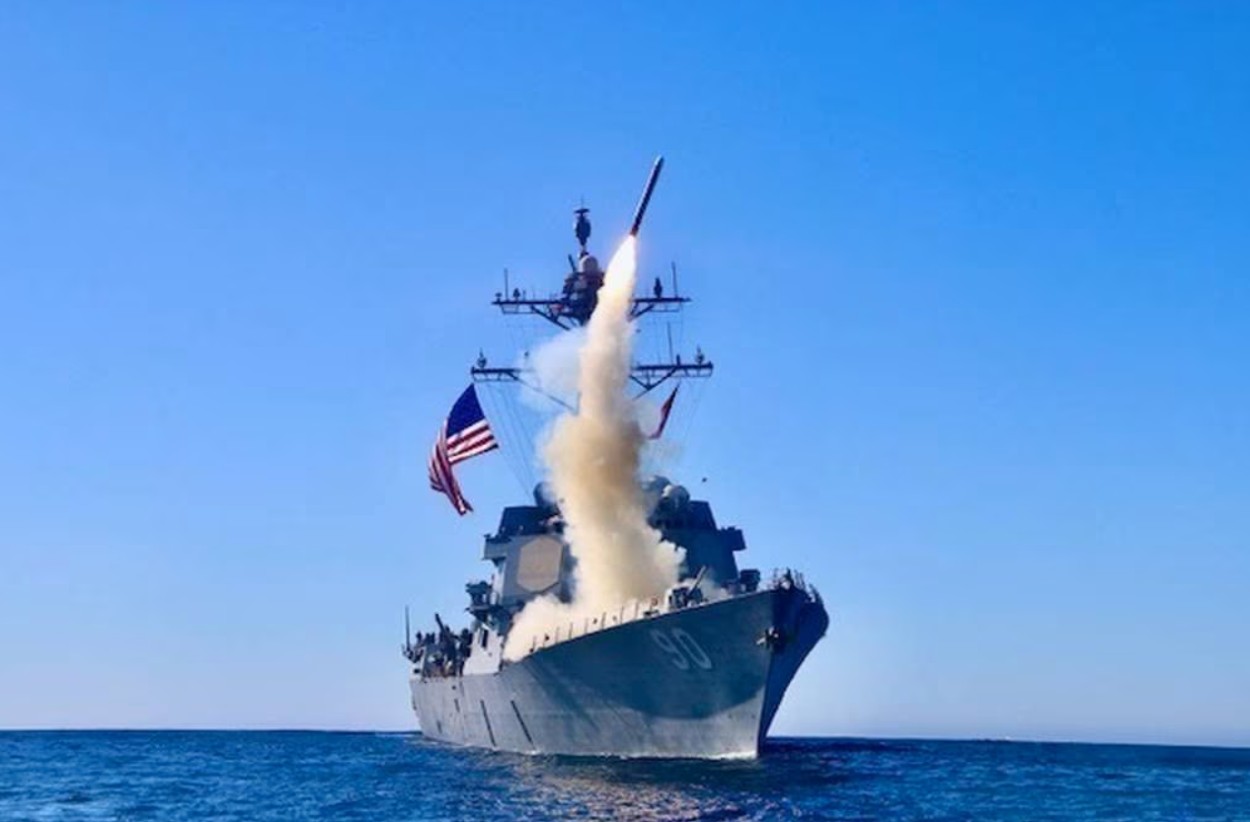After Iran, U.S. ‘Bunker Buster’ Missiles Could Threaten Russia As Trump Mulls Arming Ukraine With Tomahawks: Reports

The Donald Trump administration has made a major U-turn in policy, moving from a brief pause in arms delivery to resuming and expanding weapons support for Ukraine.
There is speculation that the new support package could include some long-range missiles, including Tomahawk, which was recently used against Iran.
The Trump administration suspended several vital arms shipments in early July 2025, including Patriot missiles and 155mm artillery ammunition, citing concerns about dwindling US stockpiles and a reassessment of military aid priorities. This pause raised alarms in Ukraine, as it faced escalating Russian drone and missile attacks.
However, in a significant about-face, Trump unveiled a new plan on July 14, aimed at dramatically increasing the supply of ammunition, missiles, and defensive systems like Patriot to NATO countries, who would then deliver them to Ukraine. According to reports, the US is expected to sell around $10 billion in weapons to NATO allies in the first wave.
While the resumption in supply of Patriot air defense launchers and missiles has already made headlines amid devastating Russian aerial strikes on Ukraine, there is now speculation that Ukraine could be armed with the Tomahawk long-range cruise missile, which is currently one of the most lethal munitions in the US arsenal.
The Washington Post reported on July 15 that the US President Donald Trump was mulling the possibility of sending Tomahawk cruise missiles to Ukraine that could hit targets deep inside the Russian territory, including cities like the capital Moscow and St. Petersburg.
Citing an unidentified informed source, the report said that while the missile has been removed from the list of weapons bound for Kyiv, it could be sent later if the US President decides to make the war more expensive for Russia.
The report comes in the wake of Trump’s frustration with Russian President Vladimir Putin, amid failed attempts at ending the war. The US President called out Putin earlier, saying, “He talks nice and then he bombs everybody in the evening.”
Trump mentioned the potential delivery of missiles to Ukraine while announcing the resumption of arms deliveries, but stopped short of naming what missiles were under consideration.
Meanwhile, a separate report in the Financial Times on July 15, citing two unnamed sources involved with the conversation, said that the US President Donald Trump asked President Volodymyr Zelensky if Ukraine would be able to attack Moscow if given long-range US missiles.”Volodymyr, can you hit Moscow? . . . Can you hit St Petersburg too?” Trump reportedly asked.
These claims could not be independently verified, and neither the White House nor the Ukrainian administration has taken cognisance of these claims at the time of writing this report. However, the EurAsian Times understands that Ukraine has long sought the Tomahawk missiles.
The first evidence of this emerged in October 2024, when The New York Times reported that the country had requested the missile as part of Ukraine’s Five-Step Victory Plan, unveiled at the time.
Citing some US insiders, the report stated that the US officials were not convinced by Ukraine’s argument about how they would use these long-range missiles to change the course of the conflict. Additionally, it disclosed that the target list given by Ukraine exceeded the number of missiles the US military could spare for Kyiv without jeopardising possible requirements for the Middle East and Asia.
The claims were indirectly accepted by Zelenskyy when he alluded to the need for a long-range missile for decisive action against Moscow, and lambasted the US officials who passed on the information to the media.
The negative trickle of information perplexed senior Kyiv authorities, with at least one unidentified official telling POLITICO, “We know the plan is realistic. U.S. own military studied it and said it is realistic.”
Nonetheless, the request was brushed under the carpet soon after, particularly as Russia had warned that the use of long-range missiles on its territory by NATO countries would be tantamount to entering a war against Russia.
However, with the war grinding on, the possibility might finally be on the table again.
Tomahawks For Ukraine
The Tomahawk cruise missiles, despite being seemingly old, have continued to be deployed in combat with a high degree of success.
For instance, these missiles were recently deployed to target Iran’s nuclear facilities as part of the US ‘Operation Midnight Hammer’ launched on June 21.
The US forces reportedly launched about 30 Tomahawk missiles alongside the 30,000-pound GBU-57 ‘bunker buster’ bombs to strike nuclear sites in Iran. But Isfahan was only struck by Tomahawk missiles launched from a US submarine located approximately 400 miles away.
The Tomahawk cruise missile is a precision weapon that can hit targets with accuracy, even in well-guarded skies. It is a subsonic, jet-powered weapon that can bypass air defenses by flying at very low altitudes and using specialized navigation systems.
The Tomahawk’s range varies from a range of 1,600 to 2,500 kilometers, depending on the variant. Its ability to combine flexibility and lethal power is what makes it so exceptional.
With this range, the Ukrainian forces would be able to strike high-value targets deep inside Russian territory, such as military airfields, command centers, logistics hubs, and production facilities for missiles and drones, which are currently out of reach for Ukraine’s existing weapons, like the ATACMS or the Storm Shadow. For example, targets in Moscow or St. Petersburg could theoretically be reached if launched from Ukraine.
Experts believe that these extremely accurate missiles, which can destroy a valuable target or a group of soldiers and weapons while still allowing for course correction after the shot has been fired, are significantly beneficial on the dynamic, modern battlefield.

Tomahawks are effective against well-defended or fortified targets due to their exceptional accuracy and ability to fly at low altitudes, thereby evading radar detection. They could strike Russian military installations with little collateral damage. This precision could disrupt Russia’s ability to sustain its war effort by targeting critical supply chains and production sites.
Tomahawk cruise missiles can demolish structures, leaving behind explosion craters up to 20 feet broad. They are powerful because they can transport a typical warhead that weighs about 1,000 pounds. The missile comes in several variants, the most popular of which are Block III, Block IV, and the latest, Block V.
A Block III features a 1,000-pound blast/fragmentary unitary warhead. For attacks against people or weapon systems in the open, the Block III Submunition version has a submunition compartment with cluster bomblets. In contrast, the Block IV version boasts significantly enhanced capabilities.
During flight, the operator can use a satellite communications system to reprogram the munition to hit a predetermined target or another coordinate.
The Block IV version features an integrated datalink that enables target switching during flight and allows it to hover for an extended period. Furthermore, in addition to assessing battle damage for commanders, Block IV can loiter over a target and hit targets of opportunity.

Meanwhile, the Block V variant features next-generation technological advancements that enable the weapon to target moving ships at sea while in flight, skimming the ocean surface beyond the radar aperture of what opponents can detect. It features enhanced communication and navigation capabilities, enabling commanders to adapt to changes on the battlefield.
The missiles have demonstrated exceptional performance in combat. They were first used by the US in Iraq during ‘Operation Desert Storm’ in 1991. The US military also attacked Al Qaeda training centers in Afghanistan with a series of Tomahawk strikes. The missile was extensively used during the Kosovo War, before showcasing its lethality in Iran last month.
It could similarly be used to expand Ukraine’s firepower at a time when it is regularly bombarded by Russian drones and missiles. Moreover, the threat of deep strikes could force Russia to withdraw its assets away from the front lines, complicating its logistics and reducing operational efficiency, as seen in the past when Ukraine introduced new weapons.
Tomahawks could also complement Ukraine’s existing arsenal, overwhelming Russian air defenses, which have allegedly shown vulnerabilities to long-range cruise missiles.
The task might not be free of challenges, as Tomahawks are primarily naval missiles and would likely require significant technical support and infrastructure to adapt them for ground launch.
- Questions and Answers
- Opinion
- Motivational and Inspiring Story
- Technology
- Live and Let live
- Focus
- Geopolitics
- Military-Arms/Equipment
- Güvenlik
- Economy
- Beasts of Nations
- Machine Tools-The “Mother Industry”
- Art
- Causes
- Crafts
- Dance
- Drinks
- Film/Movie
- Fitness
- Food
- Oyunlar
- Gardening
- Health
- Home
- Literature
- Music
- Networking
- Other
- Party
- Religion
- Shopping
- Sports
- Theater
- Health and Wellness
- News
- Culture

